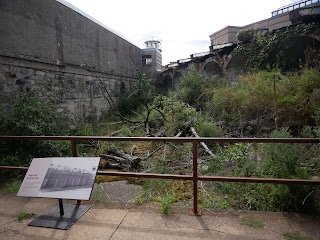Philadelphia historic landmark Eastern State Penitentiary has been on our list of places to visit. The castle-like fortress is visible from I-95, and also a short walk from the museums on Fairmont Avenue. It also has free two-hour parking alongside it. Really, we have no excuse for not visiting it sooner.
As we pulled up, Don reminded me we did visit it in mid-July 2001 as we celebrated Bastille Day at an event that promised to "let them eat Tastycake." Tastycake is a Philadelphia packaged snack. Instead of Butterscotch Crimpets, they tossed Hostess's Twinkies. I don't remember much about the event other than we walked there from Kevin's apartment.
While picking up books from the library a couple of weeks ago I noticed a flyer allowing patron's to borrow library pass to visit (with up to five friends).
Yet another excuse eliminated.
When it was originally built in the 1821 it was deemed a much more humane way
 |
| Tiny doors to enter |
to rehabilitate prisoners. Each of the original 250 prisoners would be housed in solitary confinement, allowed outside in their private courtyard for only an hour a day (divided into two half-hour shifts).They were not allowed to talk to anyone, except a clergy member who would help decided if they were truly repentant.
On October 25, 1829 they received their first prisoner. Nearly 100 years later (in 1924) prisoners were allowed to eat together. It closed in `1970, after being declared both a Pennsylvania and National Historic Landmark. It sat vacant for nearly 20 years. In 1994, after a few years of limited availability, it opens to daily tours. Nine years later an audio tour was introduced, it is still in use today (and needs minor updating that is probably more complicated than it seems).
The audio tour walks visitors through Cell Block 3 to the Round Room -- called such because it is the center of the star-shaped designed. Here guards could see what was happening from the center.
 |
| Each cell block had a barbershop. |
 |
| Solitary |
There is so much to learn at the tour. They have the first prison synagogue, as well as a chapel. There was concern that the Jewish prisoners would be converted to Christianity, so a local temple made sure their religious rights were protected. They even had a kosher kitchen. Death Row hauntingly included eerie piano music.
The prison hospital was state of the art. In 1895 they acquired the second x-ray machine in Philadelphia. We took a separate (free) tour of the hospital wing. It is normally closed to the public. As we entered the hall, our guide warned us we would be locked inside, and to let him know if we had to leave. The door creepily creaked open and slammed shut with a menacing boom. The trigger warning was appreciated.
 |
| The tuberculous wing had beds allowing inmates to sit up, and bigger doors and windows because they (erroneously) believed extra sunlight would cure them |
 |
| Room where surgery took place |
Back in its day, major surgery was performed here, with inmates helping. Later local med students came to perform procedures ranging from open heart surgery to plastic surgery (for tattoo and scar removal). Our guide was quick to tell us there is no record of medical testing being performed on the inmates.
 |
| Al Capone's cell recreated |
As you leave, tourists pass Al Capone's swanky cell. He was one of their most famous inmates. Though he lived there for only a few months, he had a desk and other furniture making it feel homey.
Many of the cells are shown in their current decrepit form There are a few photographs showing what it looked like when it was an active prison. Some of the cellblocks contain art installations.
The audio guide was key to understanding the history. Unlike when I am on vacation, I did not bring a notebook to record thoughts and facts. My audio guide needed to be help precariously in place before it would work.
I brought my camera to take pictures playing with the light and shadows, recording the peeling industrial green paint, and the weeds growing through the building. Our guide assured us it has been deemed structurally sound.
In the main courtyard is a giant 3-D model highlighting how the United States' prison population stands compared with the rest of the world. Until 2020, we had the most prisoners. Now El Salvador, Cuba, and two other countries have more than the USA on a per capital basis. (I did not take a picture of it.)
The audio guide was great, but I felt as if I was alone. Rather than pressing the start button at the same time and going through together, Don started his and was swept into the land of the electronic device. I loved the content, and did more extra tours than Don, I found the device frustrating to use.
We arrived around three, and closed the place two hours later.
 |
| View of a tower at night |


























No comments:
Post a Comment